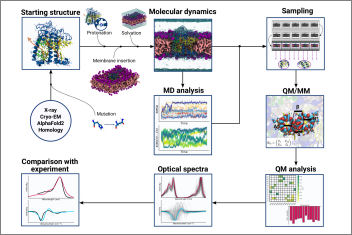 The function of light-harvesting complexes is determined by a complex network of dynamic interactions among all the different components: the aggregate of pigments, the protein, and the surrounding environment. Complete and reliable predictions on these types of composite systems can be only achieved with an atomistic description. In the last few decades, there have been important advances in the atomistic modeling of light-harvesting complexes. These advances have involved both the completeness of the physical models and the accuracy and effectiveness of the computational protocols.
The function of light-harvesting complexes is determined by a complex network of dynamic interactions among all the different components: the aggregate of pigments, the protein, and the surrounding environment. Complete and reliable predictions on these types of composite systems can be only achieved with an atomistic description. In the last few decades, there have been important advances in the atomistic modeling of light-harvesting complexes. These advances have involved both the completeness of the physical models and the accuracy and effectiveness of the computational protocols.
In this Perspective, we present an overview of the main theoretical and computational breakthroughs attained so far in the field, with particular focus on the important role played by the protein and its dynamics. We then discuss the open problems in their accurate modeling that still need to be addressed. To illustrate an effective computational workflow for the modeling of light harvesting complexes, we take as an example the plant antenna complex CP29 and its H111N mutant.







